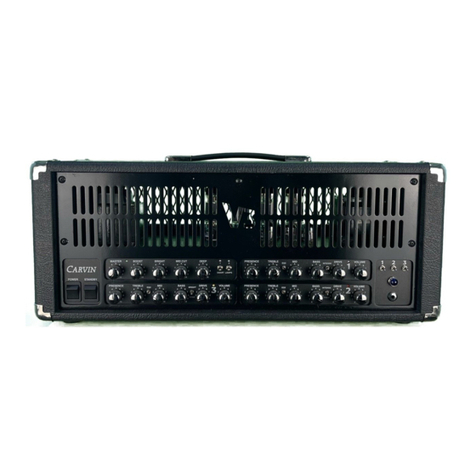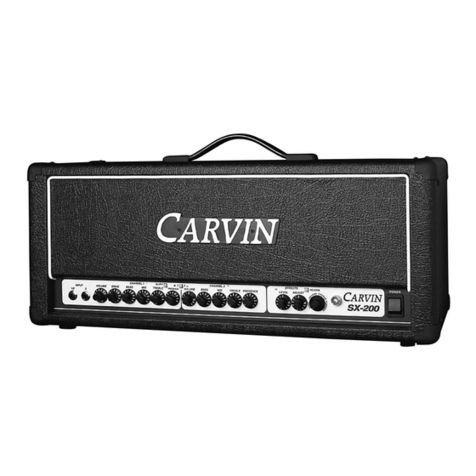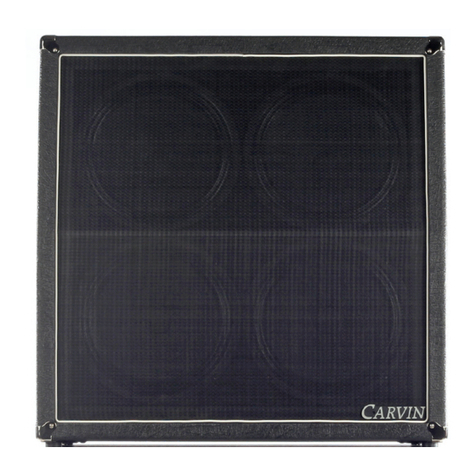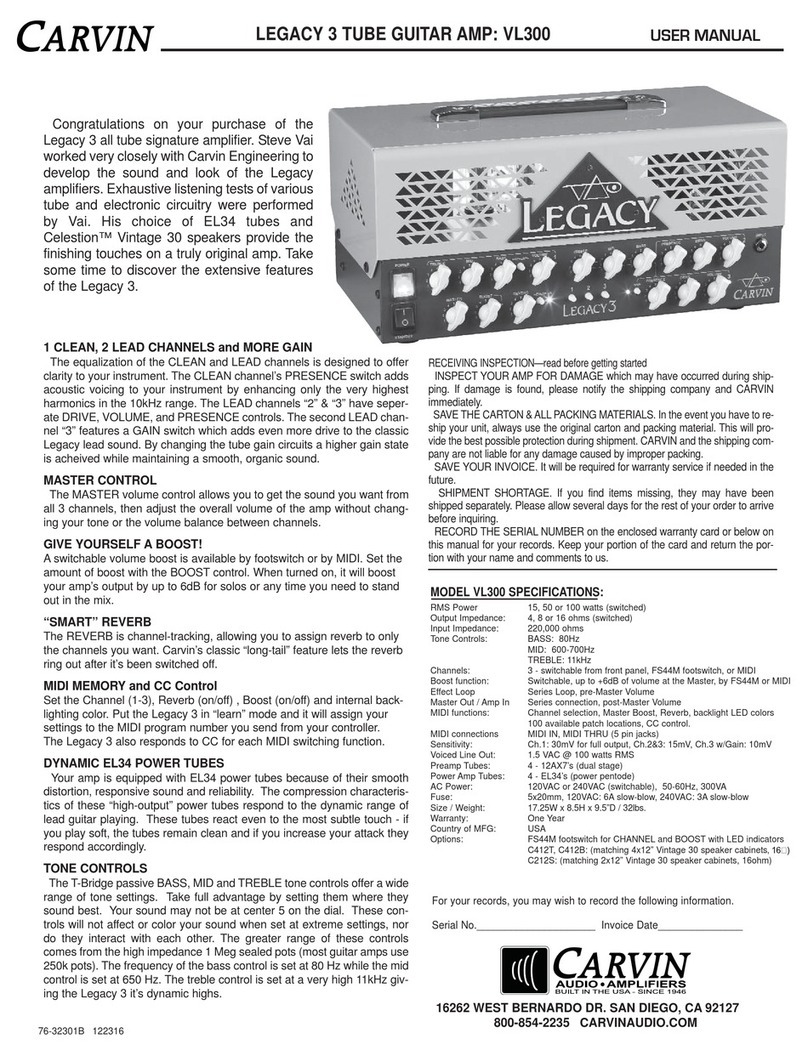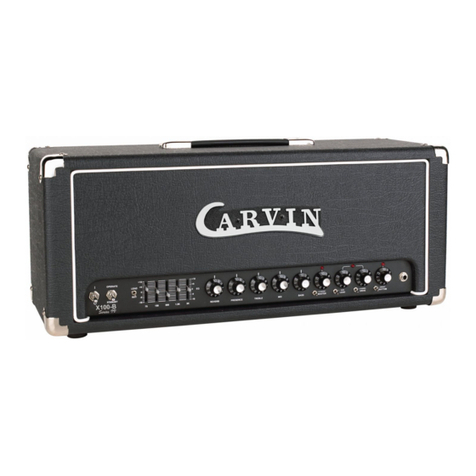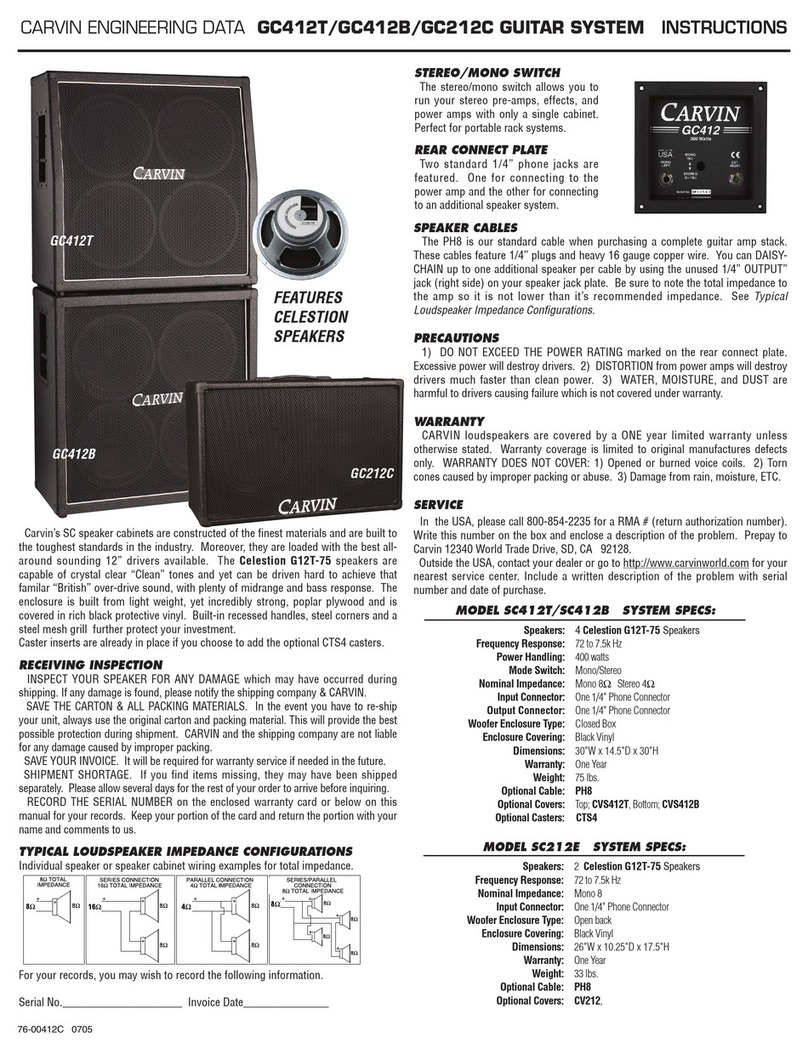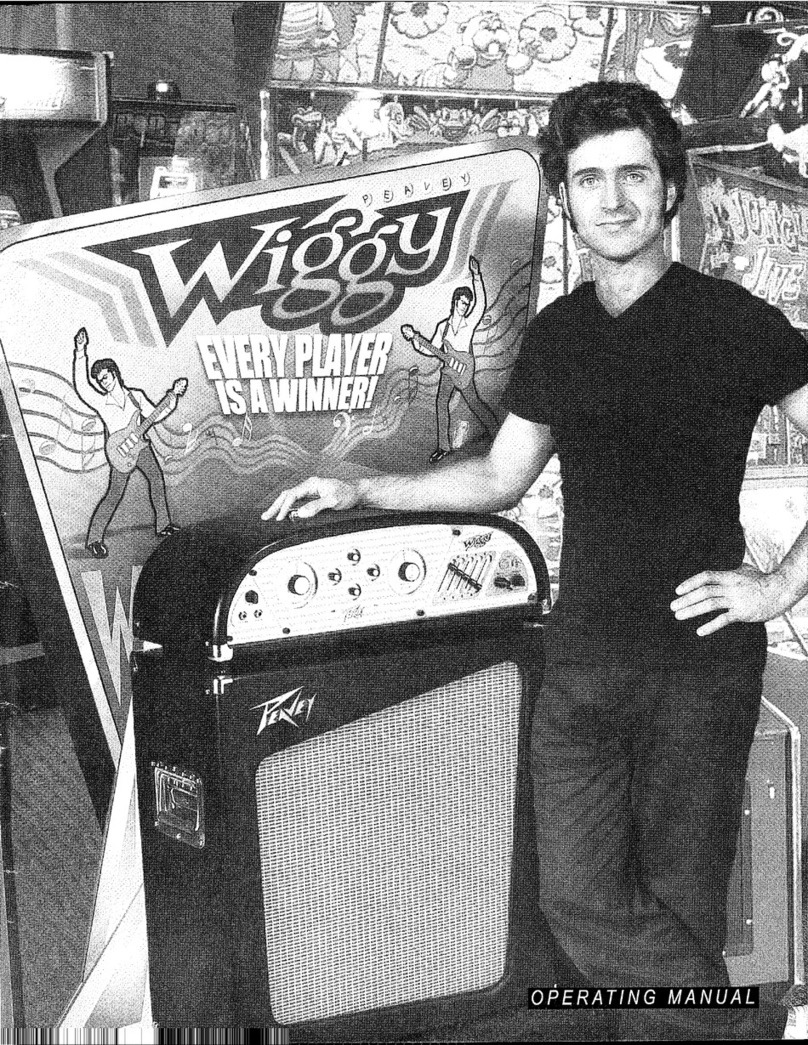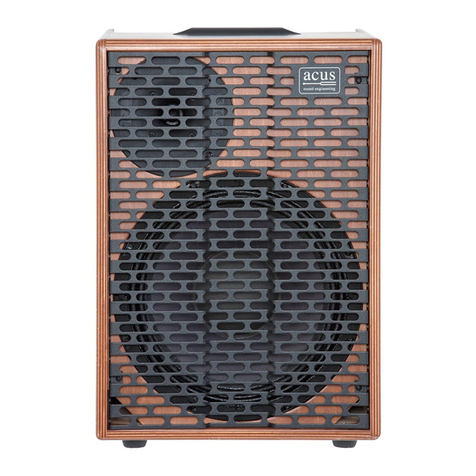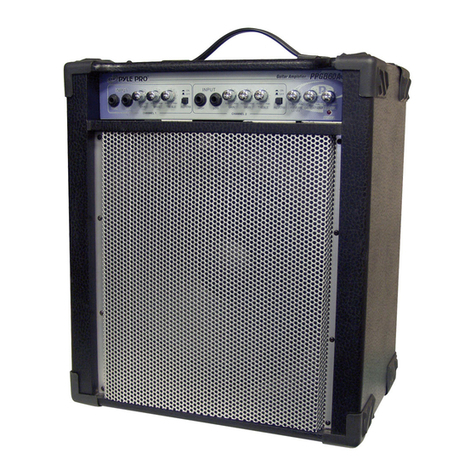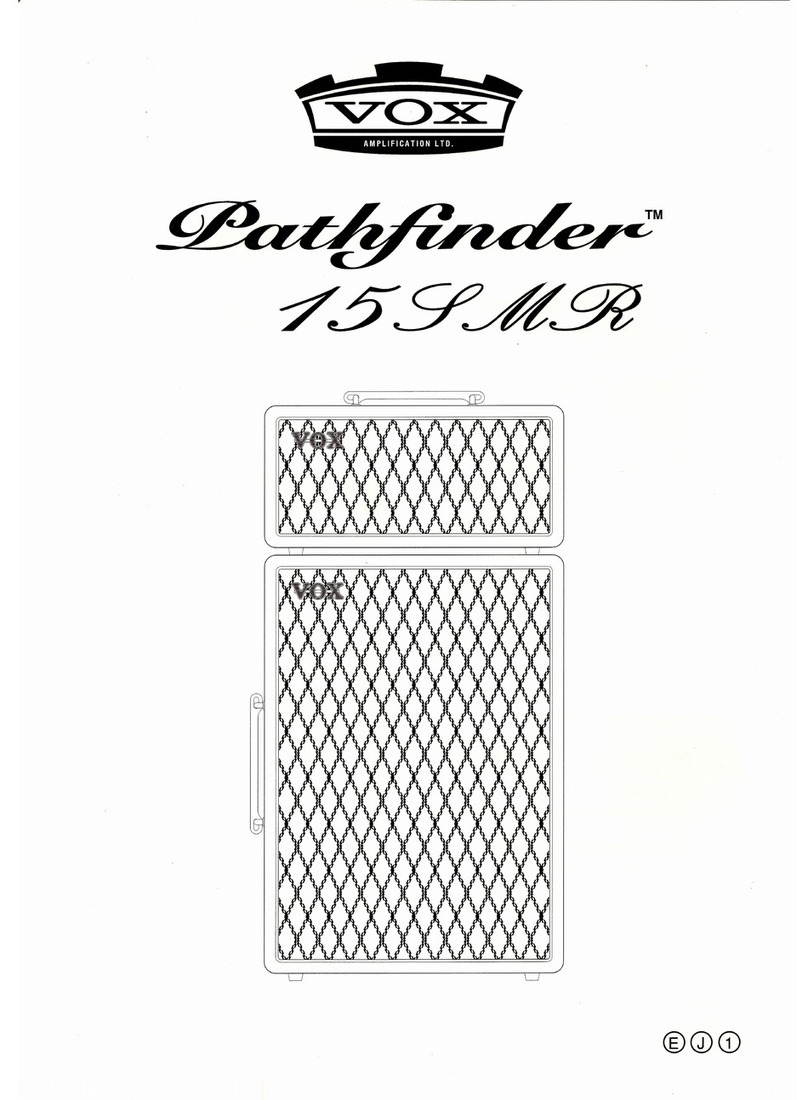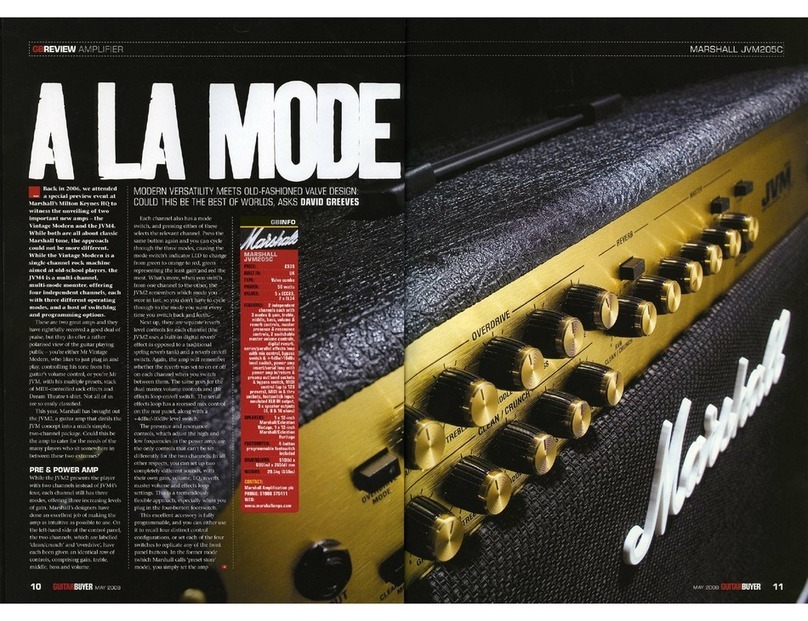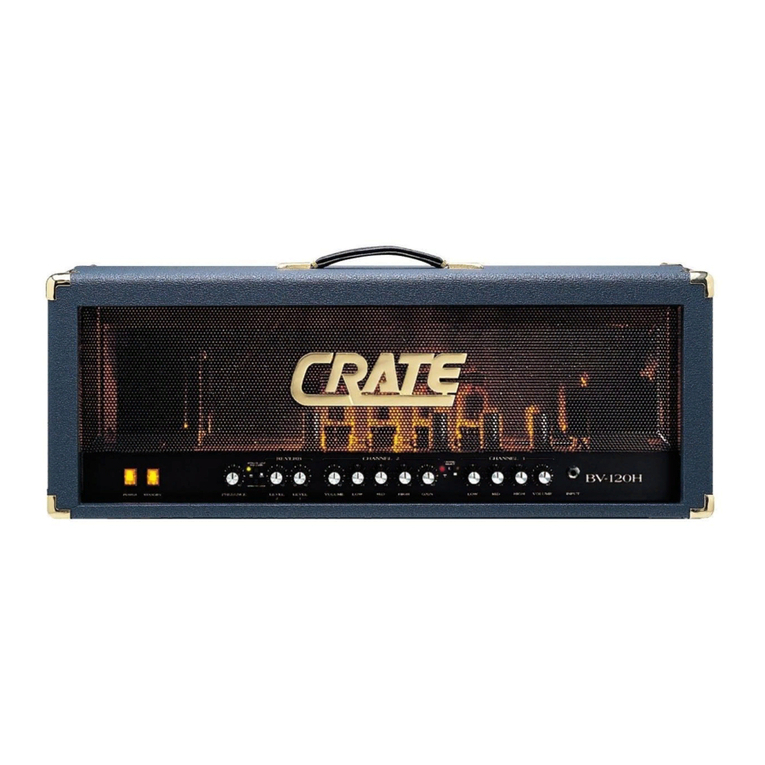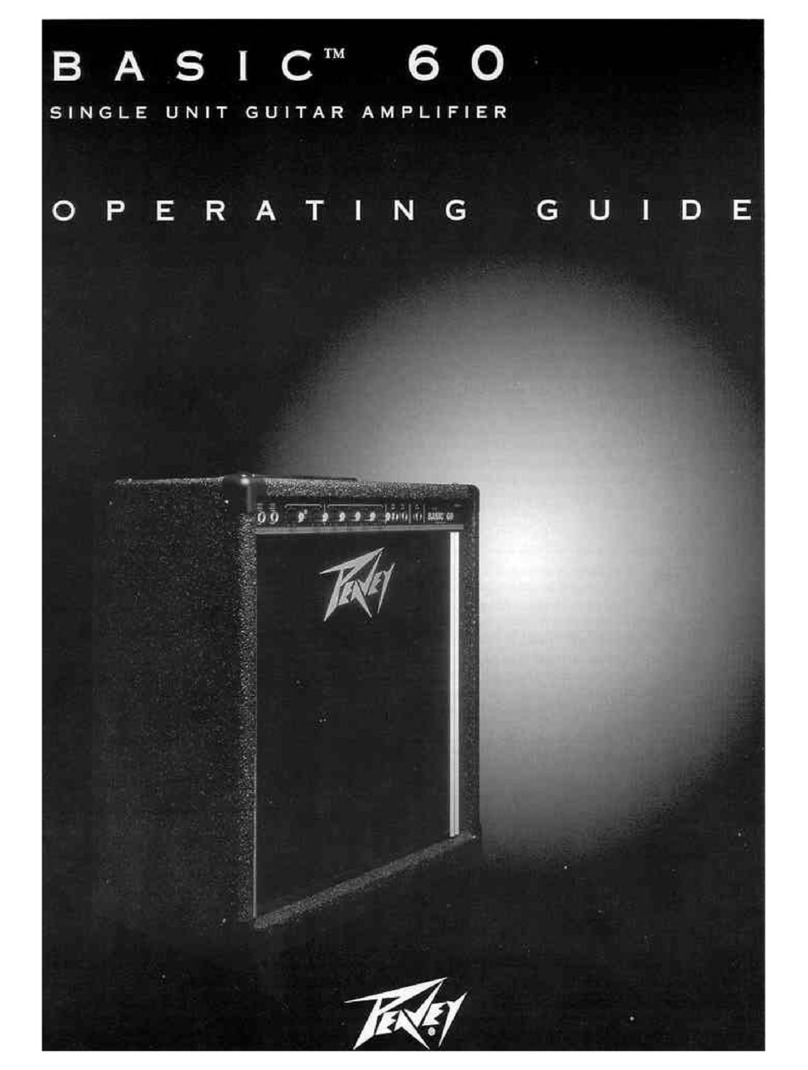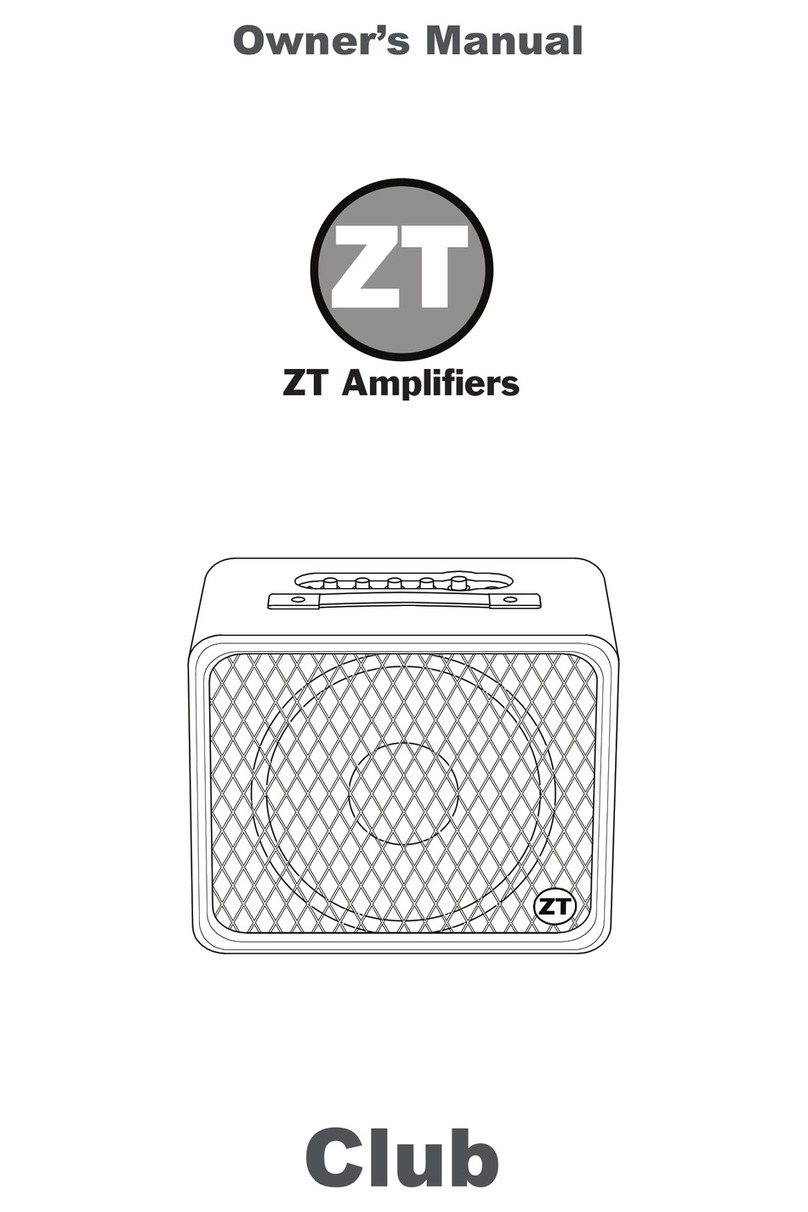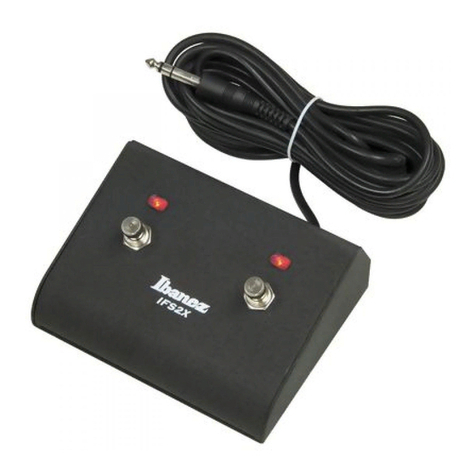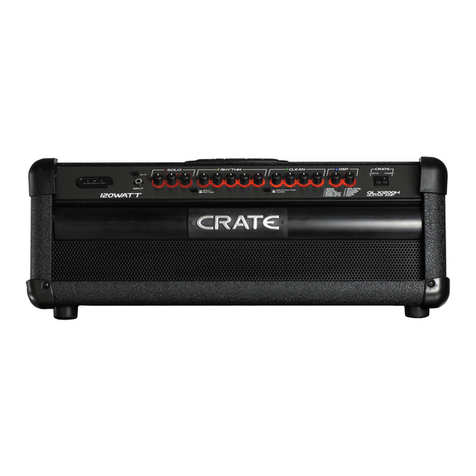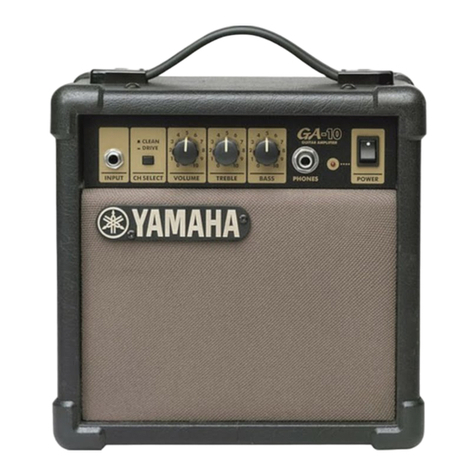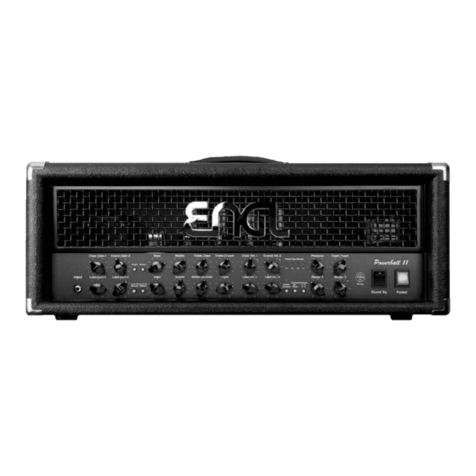CARVIN ENGINEERING DATA BR12 and BR15 BASS AMPS OPERATING MANUAL
Congratulations on your purchase of the Carvin BR12/BR15 bass
amplifier. For over 40 years we have been building bass amplifiers,
so you can expect award-winning performance from these compact pro-
fessional bass systems.
BASS SIGNAL PROCESSING
The preamp of a bass amplifier is the key to great tone. The first item
in the amp’s signal chain is the internal Class A discrete preamp cir-
cuits. Class A preamps circuits are renown for their superior sonic
detail. Secondly, your BASS, MID sweep & TREBLE controls are pow-
erful active circuits, which will add flexibility in generating your tone.
The BX120 head also features a 5 BAND GRAPHIC EQ allowing you to
put the final touches on your sound from specialized filters designed
just for the bass guitar.
The BR12 and BR15 continues with features that are only found in
the most comprehensive bass rigs. A COMPRESSOR, which is sought
out by most professionals, is featured because it controls the over-
all level of the amp regardless of where the volume control is set. You
can now control your peaks without the amp getting too loud or keep
the amp from distorting.
You may easily add to your signal processing with an effects proces-
sor to enhance your sound. Any device from a foot pedal to a full effects
rack can be plugged into the rear of the “buffered” Send / Receive
EFFECTS LOOP.
The preamp LINE/PHONES jack can also be used as a main output
from the preamp to send your signal to a mixing console or another
high powered amplifier, allowing you to use the full complement of
signal processing from your unit.
COMBO CABINET DESIGN
Part of the success of the BR12/BR14 combo amplifiers are their light-
weight design and high performance. A cabinet tuned to the speak-
ers parameters in each system adds to the speaker’s efficiency in the
35 Hz to 50 Hz range, resulting in overall warmth and a bigger,
rounder sound. The BRseries combo’s also feature a 1”Titanium HF
Driver to extend the upper range to 16k Hz, enhancing the harmonics
Specifications:
Freq. Response: 20 Hz to 20k Hz ±3 dB
THD: Typically less than .1%
RMS Power: 120 watts @ 4 ohms
Direct Out: XLR jack, GND Lift, and Level
Contour: FLAT to 250Hz/-8DB MID Cut
Tone Controls: LO: 80Hz ±12dB
(3 band with mid sweep) MID: 200-2KHz ±12dB
HI: 8KHz ±12dB
Compressor: up to 30dB reduction
Comp Thresh/Ratio: -7 to -27 dB, 3:1 ratio
5 Band Graphic EQ: 80Hz, 250Hz, 500Hz,
800Hz, & 2kHz, ±12dB
Cabinet Freq. Resp: BR12: 50 Hz to 16k Hz BR15: 41 Hz to 16k Hz
Cabinet Types: Sealed enclosure
Cabinet Construction: Baltic Birch Plywood
Tweeter Attenuation: Continuously variable
Warranty: One Year
Power Requirements: 120VAC, 225VA
240VAC, 225VA
Fuse: 5A 250V slow blow
Size and Weight BR12: 17.5Wx12Dx25H. 36 lbs. BR15:19.3Wx14.9Dx24H. 46 lbs.
Footswitch: FS22, mute and EQ
76-42120A 1106
12340 World Trade Drive, San Diego, CA 92128
800.854.2235 www.carvin.com
for percussive slap. The 1” Titanium HF Driver is fully adjustable from
a variable rear control. All enclosures are covered in durable black
DuraTuff II™ for your transporting protection.
POWER AMP
Pure, clean bass power is delivered to your speaker from the
BR12/BR15 series ultra-low distortion power amp. Turn-on muting,
short circuit and thermal overload circuits protect your speakers and
amp form accidental overloads. ( Note: It is normal for the amp to
get warm to the touch).
RECEIVING INSPECTION—read before getting started
INSPECT YOUR AMP FOR ANY DAMAGE which may have occurred during shipping.
If any damage is found, please notify the shipping company and CARVIN immediately.
SAVE THE CARTON & ALL PACKING MATERIALS. In the event you have to re-ship your
unit, always use the original carton and packing material. This will provide the best pos-
sible protection during shipment. CARVIN and the shipping company are not liable for
any damage caused by improper packing.
SAVE YOUR INVOICE. It will be required for warranty service if needed in the future.
SHIPMENT SHORTAGE. If you find items missing, they may have been shipped sepa-
rately. Please allow several days for the rest of your order to arrive before inquiring.
RECORD THE SERIAL NUMBER on the enclosed warranty card or below on this manual
for your records. Keep your portion of the card and return the portion with your name
and comments to us, or you may register online at www.carvin.com/registration.
GETTING STARTED QUICKLY
Turn the amp on and volume off, set the tone controls at their mid
“0” center position, turn the compressor and noise gate off and set
the 5 band graphic EQ to the their center/mid positions. Plug your
amp into the AC voltage and then plug in your bass. Now, turn the
amp’s power switch ON and gradually raise the volume. Re-adjust
the contour and tone controls as needed and your ready to go.
BR15
For your records, you may wish to record the following information.
Serial No._____________________ Invoice Date_______________
BR12
SAFETY INSTRUCTIONS (EUROPEAN)
The conductors in the AC power cord are colored in accordance with the following code.
GREEN & YELLOW—Earth BLUE—Neutral BROWN—Live
U.K. MAIN PLUG WARNING: A molded main plug that has been cut off from the cord is
unsafe. NEVER UNDER ANY CIRCUMSTANCES SHOULD YOU INSERT A DAMAGED
OR CUT MAIN PLUG INTO A POWER SOCKET.
IMPORTANT! FOR YOUR PROTECTION, PLEASE READ THE FOLLOWING:
WATER AND MOISTURE: Appliance should not be used near water (near a bathtub, washbowl,
kitchen sink, laundry tub, in a wet basement, or near a swimming pool, etc). Care should be taken
so that objects do not fall and liquids are not spilled into the enclosure through openings.
POWER SOURCES: The appliance should be connected to a power supply only of the type described
in the operating instructions or as marked on the appliance.
GROUNDING OR POLARIZATION: Precautions should be taken so that the grounding or polar-
ization means of an appliance is not defeated.
POWER CORD PROTECTION: Power supply cords should be routed so that they are not likely
to be walked on or pinched by items placed upon or against them, paying particular attention
to cords at plugs, convenience receptacles, and the point where they exit from the appliance.
SERVICING: The user should not attempt to service the appliance beyond that described in the
operating instructions. All other servicing should be referred to qualified service personnel.
FUSING: If your unit is equipped with a fuse receptacle, replace only with the same type fuse.
Refer to replacement text on the unit for correct fuse type.
REFER SERVICING TO QUALIFIED SERVICE
PERSONNEL! THIS UNIT CONTAINS HIGH
VOLTAGE INSIDE!
CAUTION
RISK OF ELECTRIC SHOCK
LIMITED WARRANTY
Your Carvin product is guaranteed against failure for ONE YEAR unless otherwise stated. Carvin will
service and supply all parts at no charge to the customer providing the unit is under warranty. Shipping
costs are the responsibility of the customer. CARVIN DOES NOT PAY FOR PARTS OR SERVICING OTHER
THAN OUR OWN. A COPY OF THE ORIGINAL INVOICE IS REQUIRED TO VERIFY YOUR WARRANTY.
Carvin assumes no responsibility for horn drivers or speakers damaged by this unit. This warranty
does not cover, and no liability is assumed, for damage due to: natural disasters, accidents, abuse,
loss of parts, lack of reasonable care, incorrect use, or failure to follow instructions. This warranty
is in lieu of all other warranties, expressed or implied. No representative or person is authorized to
represent or assume for Carvin any liability in connection with the sale or servicing of Carvin prod-
ucts. CARVIN SHALL NOT BE LIABLE FOR INCIDENTAL OR CONSEQUENTIAL DAMAGES.
When RETURNING merchandise to the factory, you may call for a return authorization number. Describe
in writing each problem. If your unit is out of warranty, you will be charged the current FLAT RATE for
parts and labor to bring your unit up to factory specifications.
HELP SECTION
1) AMP WILL NOT TURN ON
Check the power to the amp. Check for tripped circuit breakers, unplugged extension cords or power-
strip switches that may be turned off. Check the fuse. If a dark brownish color or no wire can be
seen within the glass tube, then replace. The amp may be perfectly fine but occasionally a fuse
may blow because of high AC voltage surges. After the fuse has been replaced with the proper
Slow Blow value and if the fuse fails again, the amp will require servicing.
2) NO OUTPUT with POWER LED light ON
Check the speaker cable. If OK, it’s possible that a speaker jack is defective. Check the SEND &
RETURN jacks as one of these jacks could be defective. Insert a guitar cord between these two
jacks to test. Defective jacks will require servicing.
3) KEEP YOUR AMP LOOKING NEW
Use a damp cloth to wipe the controls on the front & rear chassis panels. Wipe dry! Brush the lint
off the Duratuff II™ covering.
CAUTION
RISK OF ELECTRIC SHOCK
DO NOT OPEN
This symbol is intended to
alert the user to the pres-
ence of uninsulated “dan-
gerous voltage” within the
product’s enclosure that may be of suf-
ficient magnitude to constitute a risk of
electric shock to persons.
This symbol is
intended to alert the
user to the presence of
important operating
and maintenance (servicing) instruc-
tions in the literature accompanying
the appliance.
